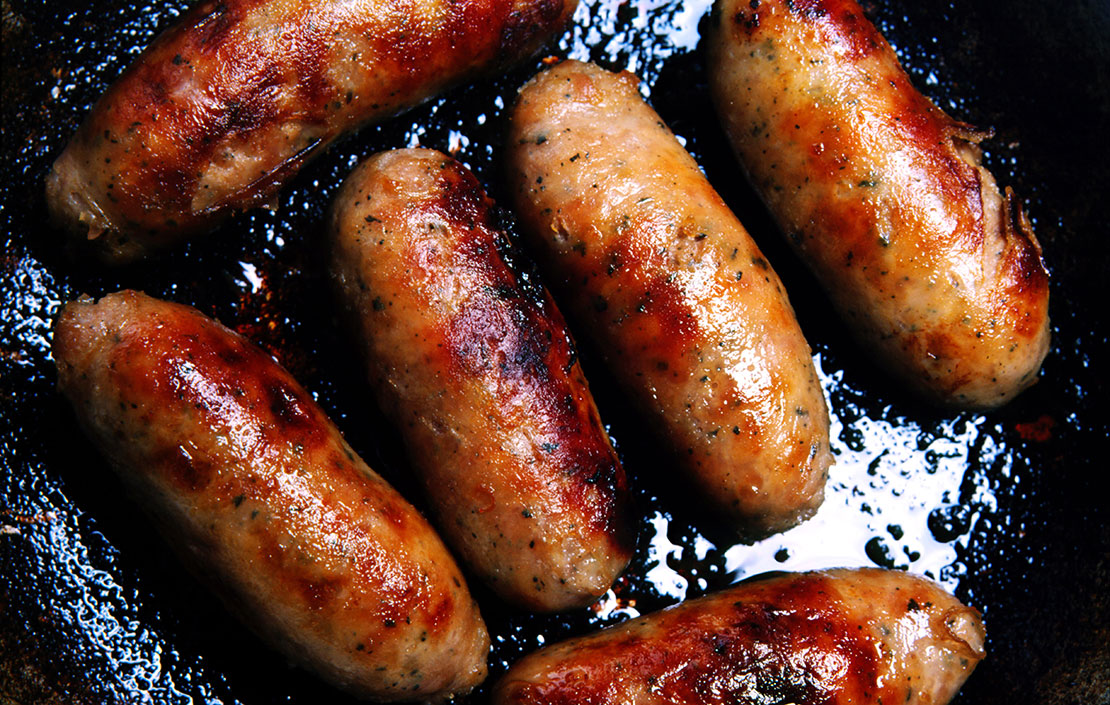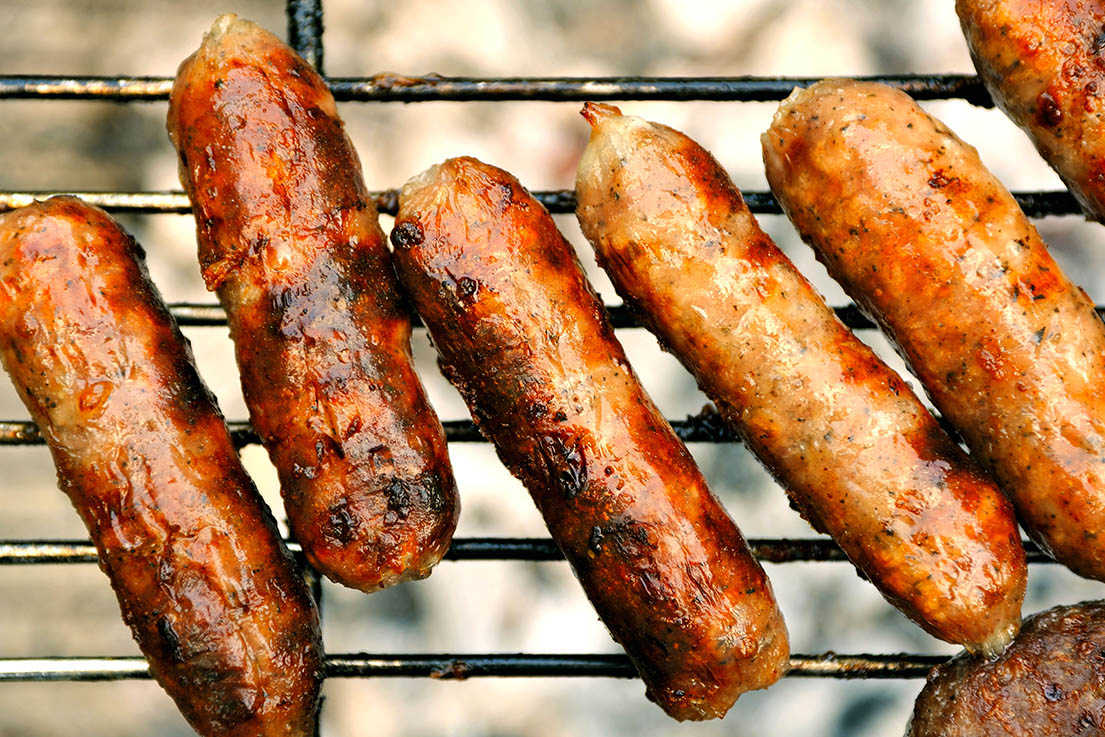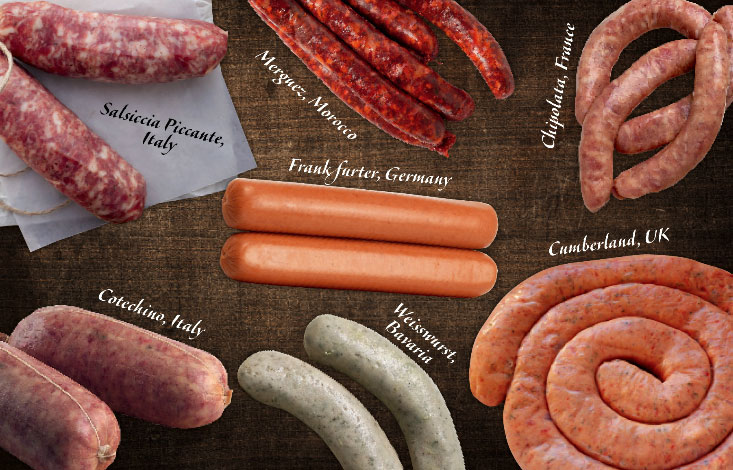In praise of the great British sausage – and five of the best bangers you can buy
Few foods are equally at home on the tables of royalty as they are at the local greasy spoon, but the sausage is one of them. Tom Parker-Bowles waxes lyrical about our brilliant British bangers.


Ah, the sausage. Emperor of breakfast, legend of lunchtime, teatime Titan and dinner’s delight. There’s a version for every whim, as many varieties as there are desires.
A fistful of plump chipolatas, messy with ketchup, pilfered from the children’s tea; a brace of burnished Lincolnshire lovelies, with a fierce smear of Colman’s, munched between drives; Cumberland, coiled like an asp, drenched in onion gravy and adorned with a pile of buttery mash. Or simply your bog-standard banger (butcher-bought, of course), anointed with brown and jammed between two soft slices of cheap white bread. Pure bliss, instant succour in a skin. All hail the cylindrical saviour.
We’re a country in love with the snag. Mad for the things, cock-a-bloody-hoop. Grilled, fried, poached, boiled or baked.
We like to bury them in batter, encase them in pastry, slip them into stew and wrap them in bacon. Empires have been built upon their backs, a life’s imprisonment risked for just one more bite.
They can be blessedly simple or wildly extravagant, served up on the tables of workhouses and country houses alike. As welcome at Fagin’s dinner as they are breakfast at Blandings, sausages are never less than democratic.

Admittedly, all manner of horrors have been hidden within those casings. Otto von Bismarck once famously compared them to laws, in that it’s better not to see them being made, and it’s true that the cheap ones can be stuffed with parts of the beast that aren’t exactly prime, to say the least.
The versions served up at my prep school were an affront to good taste, little more than gristly, barely edible despair – or, in the eternal words of Jonathan Meades, ‘condoms stuffed with slurry’.
Sign up for the Country Life Newsletter
Exquisite houses, the beauty of Nature, and how to get the most from your life, straight to your inbox.
But enough of the base and debased. This is a celebration of a great British art, of the fresh regional sausage, from Cambridge (pork, rusk, sage, cayenne, mace and nutmeg) and Gloucester (Old Spot, lots of meat, a good whack of sage) to Oxford (pork, rusk, lemon peel, nutmeg, sage, thyme and marjoram) and Tunbridge Wells (coarse-cut pork, breadcrumbs, white pepper, sage, mace and herbs).
Not forgetting the chipolata (named after the Italian for onion, cipolla, although it rarely contains any these days) and, for me, the greatest of all – the breakfast banger.
Had I the time and space, I would dive into puddings, white and black, and faggots, too. I would then move onto the great boiling and grilling sausages of Europe, the boudins and saucisses of France, Italy’s cotechino and zampone and all manner of magnificent German Wurst. Sausages that usually do away with the rusk, favour a coarser cut and contain up to 100% meat.
And I haven’t even started on all things Continental, dried and smoked, an art that, traditionally, we never really favoured – why, I’m not entirely sure. ‘After all, England and France were once joined together,’ write Antony and Araminta Hippisley Coxe in the eternally succulent The Book of the Sausage. ‘But perhaps we were better content to produce good bacon and ham.’

However, I digress and need to rewind because, wherever there is life – and appetites – there is sausage. Sumerians and Assyrians were stuffing meat into animal innards 5,000 years back. Homer talks of blood sausage in the Odyssey and the Romans had a huge appetite for the likes of farcima (hence farce or forcemeat), tobelli and tomacula. Even the actual word sausage comes from the Latin salsisium, or something salted.
The high tables of medieval England were awash with highly spiced white puddings (and even a 15th-century black version, made with porpoise blood and stuffed into its gut), but sausages as we know them today didn’t really emerge until the late 17th century, when they were twisted into links – albeit stuffed with rabbit and capon, rather than pork or beef.
A century or so later, they’d moved below the salt – to fairs, in particular, where stalls known as Wilkes’ Parlours (places of dissent, far from the gaze of the State) served up sausages and libertarian good times. Oscar Wilde even had sausages thrust into his cell in Reading Gaol, like ‘buns at a bear through the bars of a cage’.
It was only in the past 100 years that the traditional British sausage, as we now know it, truly emerged, usually containing rusk or breadcrumbs, an ingredient seen as a cheap filler by many.
David Lishman, of Lishman’s of Ilkley, is a true meat master and agrees that parsimony was part of the reason old bread was used. Its introduction ‘meant that the texture and flavour was lighter. Bread was changed to rusk (a dry form of bread) as time went on, but the British style of sausage was already ingrained in the public mind and tastebuds’.
A vocal member of the anti-rusk league is my friend Matthew Fort, food writer and former restaurant critic of The Guardian. He favours a Continental-style banger, with a very high percentage of coarsely chopped meat. For him, La Salama da Sugo, ‘the great boiling sausage of Ferrara, an atomic bomb of flavour and salt’, is the king of them all. He will admit that rusk may have a place (see the list of best five bangers below), but is still prone to the odd sneer. For me, however, nothing beats the brilliant breakfast banger.
‘Sausages got bad press during rationing times, when meat was scarce and bread was used too heavily,’ explains Mr Lishman.
‘They exploded in the pan because of this, hence the term bangers. Nowadays, we make a traditional breakfast sausage containing about 10% rusk.’
Another great (and gloriously outspoken) butcher, Lee ‘Frosty’ Frost of W. H. Frost in Chorlton, Manchester, agrees. ‘Rusk isn’t essential, but I advise it – a good-quality rusk (ours comes from Yorkshire), well fed with ice-cold water (this is essential), binds all the ingredients well.’
Mr Frost, like any decent butcher, is a great believer in using the best-quality pork, ‘with great, white creamy fat’. The Gloucester Old Spot is ideal, using a mixture of shoulder and belly. Like Mr Lishman, he uses a natural casing of hog ‘for fat bangers’ or sheep for chipolatas. ‘Finally, well-blended seasonings and spices are always essential.’
Clare Heanen, director of my favourite London butcher, H. G. Walter, likes Old Spot, too, as well as other naturally fatty breeds such as Oxford Sandy Black and Large Black. Its classic sausages have 86% meat content, a mix of shoulder and belly with 70%–75% meat to 25%–30% fat. Its British breakfast sausage has 8% rusk, ‘essential to keep the succulence of the sausage’. As for casing, it’s natural hog: ‘Stay away from the synthetic,’ she urges. All three butchers make some of the finest traditional bangers you’ll ever taste.
Rather than arguing the merits of British versus Continental style, I believe we should embrace them all. It’s not as if we need another row over anything European. ‘It’s horses for courses,’ smiles Mr Lishman.
‘A traditional English breakfast or bangers and mash would have the lighter, more conventional sausage in it. A more robust stew would be better served with a firmer, meatier Continental-style sausage.’
So there! Forget about Government legal requirements (some nonsense about containing 42% minimum pork) and put your faith in your butcher, good-quality pork (at least 75%), a decent ratio of fat, natural casings and a special spice blend.
Oh, and as Miss Heanen points out: ‘You need to have the passion.’
Bid goodbye to the bland, farewell to the mass-produced. Sausage-making is an art, the butcher its mighty, meaty muse. Bow down to the splendour of sausage.
Five of the best British sausages you can buy
Banger with cracked pepper from W. H. Frost
88% meat content, a little rusk and a mix of shoulder and belly. Good warmth at the back and good pig flavour.
W.H. Frost, 12–14, The Square, Chorlton-cum-Hardy, Manchester – W.H. Frost on Facebook
Chipolatas from H. G. Walter
Medium-cut, good pork flavour, pepper, rusk and mace. An all-purpose classic.
H.G. Walter, 51, Palliser Road, Barons Court, London W14 – www.hgwalter.com
Lishman’s Champion Pork sausage
Simple, but brilliant. 75% belly and shoulder, 10% rusk, plus salt, white pepper, mace, nutmeg, ground coriander and parsley.
Lishman’s Of Ilkley, 25, Leeds Road, Ilkley, West Yorkshire – 01943 609436; www.lishmansbutchers.co.uk
Breakfast sausage from Jago Butchers
I first tasted this at breakfast in Northumberland. My hosts had tried about three dozen different kinds before they found this sausage, a classic with lots of pork, a little rusk and various traditional herbs and spices. A classic breakfast banger.
Jago Butchers, 9, Elystan Street, Chelsea, London SW3 – Jago on Facebook
Stephen Curtis’s Horsley Plain Pork Banger
Coarse-cut, a little rusk, mace and pepper. The one traditional breakfast banger of which Matthew Fort approves.
Stephen Curtis’s sausages are sold at Nailsworth farmer’s market in Gloucestershire once a month, as well as at the village shops in Horsley, Forest Green and Uley, among other places
Tom Parker Bowles is food writer, critic and regular contributor to Country Life.
-
 Designer's Room: A solid oak French kitchen that's been cleverly engineered to last
Designer's Room: A solid oak French kitchen that's been cleverly engineered to lastKitchen and joinery specialist Artichoke had several clever tricks to deal with the fact that natural wood expands and contracts.
By Amelia Thorpe
-
 Chocolate eggs, bunnies and the Resurrection: Country Life Quiz of the Day, April 18, 2025
Chocolate eggs, bunnies and the Resurrection: Country Life Quiz of the Day, April 18, 2025Friday's quiz is an Easter special.
By James Fisher